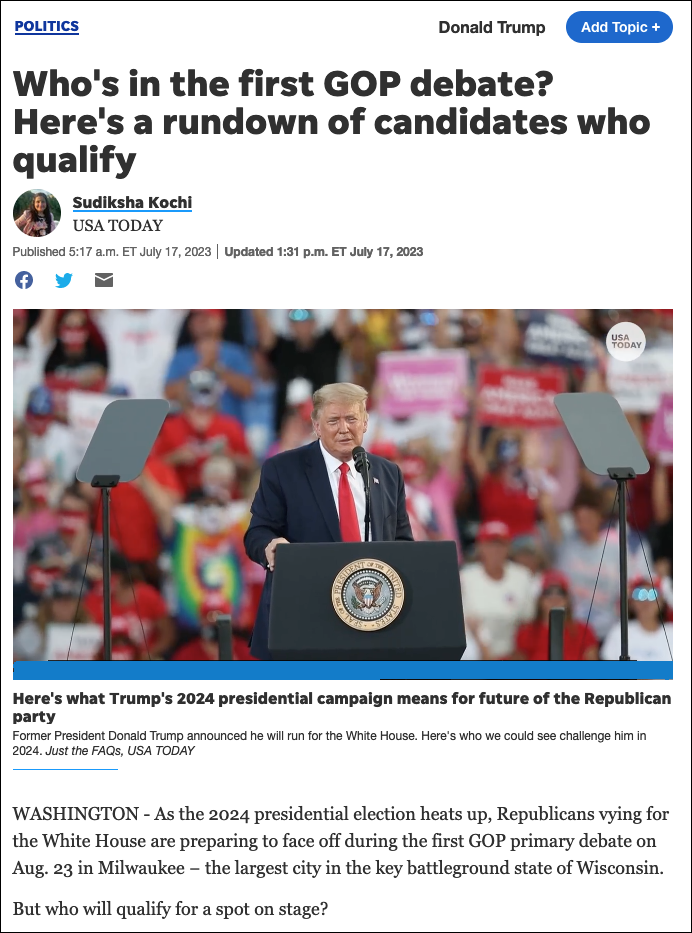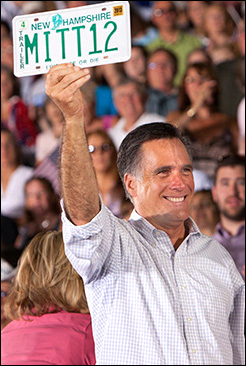By Jim Ellis — Wednesday, July 19, 2023
President
Debate: Projected Qualifiers — USA Today is projecting that six GOP presidential contenders will qualify for the Aug. 23 debate to be aired on FOX News, while another half-dozen may miss the cut. The candidates meeting the polling and donor requirements are, as expected, former President Donald Trump and Florida Gov. Ron DeSantis. The others are ex-UN Ambassador Nikki Haley, businessman Vivek Ramaswamy, Sen. Tim Scott, and former New Jersey Gov. Chris Christie.
Those on the cusp of failing to meet the participation requirements are former Vice President Mike Pence, ex-Congressman Will Hurd, Gov. Doug Burgum (R-ND), ex-Arkansas Gov. Asa Hutchinson, Miami Mayor Francis Suarez, and commentator Larry Elder.
Senate
Ohio: Sec of State Announces for Senate — As has been long expected, a third major Republican has joined the US Senate primary hoping to advance into the general election to oppose incumbent Sen. Sherrod Brown (D). Frank LaRose was first elected as Ohio’s Secretary of State in 2018 after serving two terms in the Ohio state Senate from the Akron area. He averaged 55 percent of the vote in his two victorious statewide campaigns.
LaRose is the only one of the three GOP candidates – the others being state Sen. Matt Dolan (R-Chagrin Falls) and businessman Bernie Moreno – who has won a statewide race. Sen. Dolan ran for the US Senate in 2022 but lost the Republican primary. Moreno was also in that Senate race but withdrew before voting began seeing no reasonable victory path.
While LaRose is the only statewide official in the race, he begins well behind in the money race. Sen. Dolan has already invested $4 million into his campaign. Moreno reports raising $2.26 million in the 2nd Quarter.
The general election will be difficult since Sen. Brown is a three-term incumbent. The state, however, is significantly more Republican than when the senator last ran in 2018. The ’24 contest is becoming a must-win for the GOP if the party is to capture the Senate majority in the coming election.
Senate Finance: Q2 Dollar Numbers Reported — The 2nd Quarter fundraising numbers have been released, and the 58 reporting Senate candidates in the 34 races attracted a cumulative $91.7 million and have more than $228 million in their campaign accounts. This does not count any money that Super PACs have raised or plan to spend to affect the outcome of the 2024 US Senate electoral contests.
Rep. Colin Allred (D-Dallas) was technically first in funds raised with $8.63 million, but $2.5 million of that total was transferred from his House committee. Rep. Allred’s potential general election opponent, Sen. Ted Cruz (R), ranked sixth overall but first among Republicans. He attracted $3.35 million in financial support.
California Rep. Adam Schiff (D-Burbank) was the net Q2 fundraising leader, bringing in $8.17 million without any transfers from his House account. He also led the all-important cash-on-hand category with a whopping $29.8 million ready to spend on his Senate campaign. The total amounts raised during this early campaign phase suggest that we can expect another hotly contested campaign season next year.
House
CA-9: Republicans Gain Strong Candidate — Stockton Mayor Kevin Lincoln, a Republican elected in a heavily Democratic city, is reportedly preparing an announcement for Thursday indicating he will forego running for a second term in his present position in order to challenge Rep. Josh Harder (D-Turlock) for the US House seat. Rep. Harder was severely redistricted in the 2021 redraw, but still managed to record a 55-45 percent victory over San Joaquin County Supervisor Tom Patti (R). The congressman had a huge 6:1 advantage in resources, which became a key factor in his re-election victory.
The CA-9 district could be one to watch nationally. Republicans must defeat several sitting Democratic incumbents if they are to hold their small House majority and this northern California seat, that the FiveThirtyEight data organization rates as D+8, could be on the cusp of becoming a top-tier conversion target.
Governor
Indiana: Newcomer May Enter Open Gov Race — Indiana Secretary of Commerce Brad Chambers (R) announced he will be resigning his position and it is anticipated that he will quickly declare his gubernatorial candidacy.
Though starting well behind the open race’s two front runners for the Republican nomination and the general election, US Sen. Mike Braun and Lt. Gov. Suzanne Crouch, Chambers, who has the financial ability to self-fund his campaign, may soon become the fourth credible candidate in the field. Venture capitalist Eric Doden also has the ability to attract enough resources to propel his candidacy. Incumbent Gov. Eric Holcomb (R) is ineligible to seek a third term. Sen. Braun is foregoing a second term in the Senate to enter the gubernatorial campaign.



